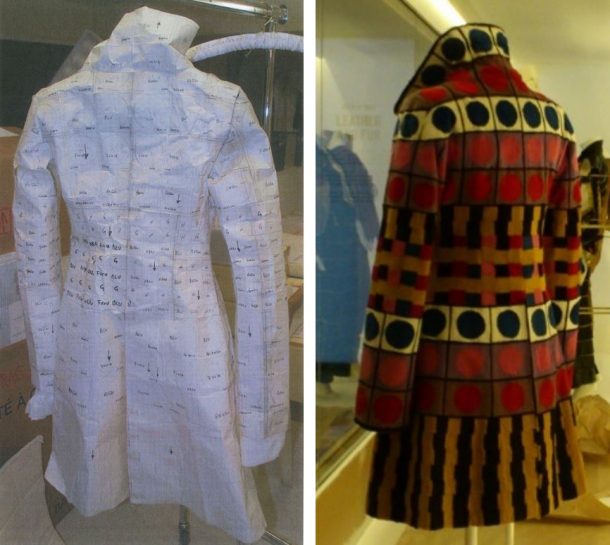The Glamour of Italian Fashion demonstrates the amazing scope of work created by a variety of designers over several decades. One of the very special parts of this exhibition is the opportunity to see some of the “behind the scenes” workings of the fashion houses – print samples, fashion sketches and videos all give an intriguing glimpse at something usually hidden. My favourite hidden treasure has to be the paper coat pattern from Fendi.
The natural assumption when someone says they have a paper pattern is of a few flat pieces of tissue with lots of “sew here” and “cut here” markings. A mink fur coat requires something a little different though. This pattern was delivered as a complete paper version of the final coat, padded out with tissue paper…no flat packets involved, only a rather large box!

The story of the Fendi mink coat starts with a design sketch by Karl Lagerfeld in pen and wax colour for the “Inlaid Polychromies” collection, 2000-2001. The pencil drawing highlights the shape desired by the designer and details such as the double-breasted fastenings and the dramatic collar. The paper pattern outlines exactly when and where different pieces should be placed and in what colour. If all the pattern pieces had been cut out individually there would have been 100s of pieces. The pattern is made of a standard weight pattern paper and held together with clear sticky tape. Pins are used in place of buttons to hold the coat closed. Every single square, circle and outline has an initial inked on it relating to the final colour of fur. Even details such as the lining of the collar and button placement are featured on the full-size paper model. The fur maquette allows the makers to work out how they will construct the garment and to experiment with colours

The combination of these three crucial pieces of the fashion puzzle – design, colour, manufacture – are all pulled together to produce the final garment.

It’s a very rare treat to be able to see the paper pattern stood side-by-side with the final garment and the combination adds to how impressive it is as a working, technical document. It is this craftsmanship and attention to detail that really highlights the quality expected from something “Made in Italy”.
See all four objects mentioned here in the “Made in Italy: Leather and Fur” section of The Glamour of Italian Fashion. If you have any questions, just let us know below!

What a work!! I was dying to buy some thing like this but online womenswear stores were very confusing until I researched properly. And finally I found what I wanted.